 Brand X Pictures/Thinkstock
Brand X Pictures/Thinkstock
Getting a good night’s sleep is important for your body to function at its best. But for some people, getting restful sleep can be difficult. It may be due to medications they are using, medical conditions or lifestyle choices.
While some barriers to sleep may require medical intervention, good sleep hygiene may help with others. One example of sleep hygiene that may help individuals with trouble sleeping is setting up a good sleeping environment.
One way to create a good sleeping environment is to make your bedroom more comfortable. This may include finding a new mattress if your current one is too hard or too soft for you.
The University of Maryland Medical Center noted that an uncomfortable bed can interfere in getting a good night sleep. In addition to evaluating the comfort of your mattress, also make sure the temperature in your bedroom is comfortable as well.
The National Sleep Foundation stated that for many people, having their bedroom temperature be above 75 degrees Fahrenheit or below 54 degrees Fahrenheit can disrupt their sleep. The organization recommended keeping your bedroom slightly cooler.
Try to also keep your bedroom dark at night. The body’s sleep-wake cycle is affected by the amount of light — bright light tells the body to be awake, and darkness signals that it may be time to sleep. To keep your sleep-wake cycle on track, get exposure to bright light during the daytime, then keep your bedroom dark at night. This may involve using drapes or an eye mask.
If you find that you wake up earlier in the morning than you are planning to, the National Sleep Foundation recommended increasing the amount of bright light exposure you are getting in the evening.
Noise is another factor to consider when creating a good sleeping environment. Distracting noises can keep you awake at night. To keep those noises from interfering in your sleep, try using a “white noise” machine or earplugs.
You can also keep the noise down in your own space by keeping the bedroom a place for sleep and intimacy. This involves taking the television, smartphone or any other distracting device out of the bedroom. Besides keeping distracting noise to a minimum, it also tells your body that the bedroom is a place for sleep, not work.
References
Better Health Channel. Sleep Hygiene. Web. 5 March 2012
http://www.betterhealth.vic.gov.au/bhcv2/bhcarticles.nsf/pages/Sleep_hygiene
University of Maryland Medical Center. Sleep Hygiene. Web. 5 March 2012
http://www.umm.edu/sleep/sleep_hyg.htm
National Sleep Foundation. The Sleep Environment. Web. 5 March 2012
http://www.sleepfoundation.org/article/how-sleep-works/the-sleep-environment
Reviewed March 5, 2012
by Michele Blacksberg RN
Edited by Jody Smith





Add a CommentComments
There are no comments yet. Be the first one and get the conversation started!